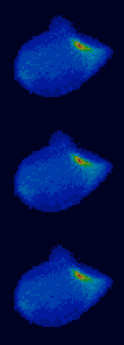Group research overview

The subcellular signalling organisation as a mediator of signal tuning in T cell activation
Cells, in particular cells of the immune system, have to continuously adjust to changing physiological conditions. Flexibility in doing so is afforded by complex signalling systems of dozens of interacting proteins. T cells are the central regulatory cells of the adaptive arm of the immune system and critical cytolytic effectors in the immune responses to viruses and cancer. A single receptor, the T cell receptor, mediates immunological recognition. However, large families of costimulatory and coinhibitory receptors amplify or attenuate the T cell receptor signal to allow adaptation to changing physiological conditions. We are interested in understanding how T cell signalling is thus tuned in health and disease.
For unique access to signal tuning, we study T cell signalling as it occurs inside live cells in the form of spatiotemporal distributions of signalling intermediates in the physiological activation of primary T cells by antigen presenting cells: In T cell activation, as in the activation of most other cell types, ligand-engaged receptors and signalling intermediates are not evenly distributed throughout the cell, but enrich in distinct locations at distinct times. At the system scale such uneven signalling distributions govern the information flow through the signalling network. By combining large scale and quantitative live cell imaging of signalling in primary T cells activated by antigen presenting cells with the manipulation of spatiotemporal features of signalling intermediates we harness the regulatory information encoded in signalling organisation to understand and control the regulation of T cell function.
As the foundation for our work, we have imaged by now >90 elements of T cell activation yielding live cell imaging data on ~20,000 T cell/APC couples with >200,000 data points. We have complemented large scale imaging with comprehensive computational image analysis (Roybal et al., Sci. Signal., 9, rs3). Spatiotemporal distributions are highly diverse. Therefore a change in the localization of even a single signalling intermediate will differentially affect many signalling interactions: Spatiotemporal distributions have great potential as an efficient and sensitive regulator of T cell signalling. Providing a mechanistic foundation, cell biological structures driving signalling organisation have emerged (as reviewed in Roybal et al., Immunol. Rev., 256,133), such as a transient actin-based lamellum with embedded small signalling complexes (Roybal et al., PLOS ONE, 10, e0133299).
Based on this foundation we have addressed basic and applied questions in the tuning of T cell signalling. We have investigated how costimulation by CD28 regulates actin dynamics as a central driver of signalling organisation (Roybal et al., Sci. Signal., 9, rs3). We have shown that deletion of a single tyrosine kinase, Itk, significantly alters the spatiotemporal distributions of > 80 % of the signalling intermediates studied. Importantly, changes in localisation can drive function without altering the cell-wide activity of a signalling intermediate (Singleton et al., Sci. Signal., 4, ra66). We have identified the generation of a signalling lipid, phosphatidylinositol 4,5 bis-phosphate (PIP2), in distinct locations within the T cells as a key regulator of T cell rigidity and organisation with consequences all the way to IL-2 secretion (Sun et al., PLOS ONE, 6, e27227). We apply imaging of T cell signal transduction to questions of medical interest. Controlling the dynamics of Cdc42 activation proved critical for the efficiency with which cytolytic effectors kill their targets (Sinai et al., PNAS, 107,11 912). Transience in cell coupling between T and B cells was related to susceptibility to the autoimmune disease systemic lupus erythematosus (Sinai et al., EJI, 44, 3522). Still unpublished we investigate signalling changes during peptide therapy in a model of multiple sclerosis and in the suppression of the function of cytotoxic T cells in the tumour microenvironment. System investigations of T cell signalling organisation thus offer unique access to understanding the tuning of T cell function in health and disease.
